2015 NISSAN GT-R lock
[x] Cancel search: lockPage 279 of 358
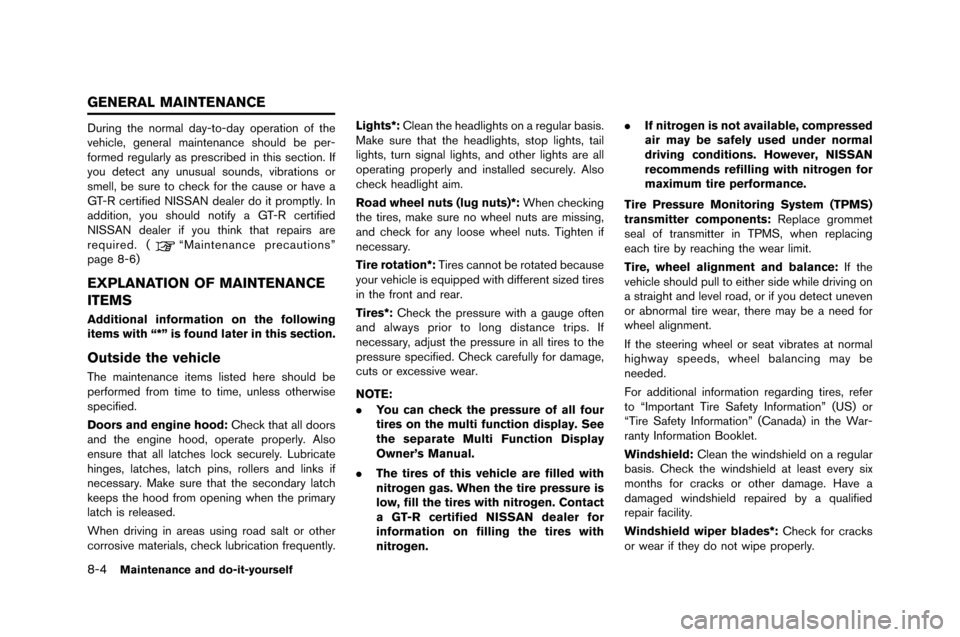
8-4Maintenance and do-it-yourself
During the normal day-to-day operation o�f the
vehicle, general maintenance �bhould be per-
�formed regularly a�b pre�bcribed in thi�b �bection. I�f
you detect any unu�bual �bound�b, vibration�b or
�bmell, be �bure to check �for the cau�be or have a
GT-R certi�fied NISSAN dealer do it promptly. In
addition, you �bhould noti�fy a GT-R certi�fied
NISSAN dealer i�f you think that repair�b are
required. (
“Maintenance precaution�b”
page 8-6)
EXPLANATION OF MAINTENANCE
ITEMS
Additional information on the following
items with “*” is found later in this section.
Outside the vehicle
The maintenance item�b li�bted here �bhould be
per�formed �from time to time, unle�b�b otherwi�be
�bpeci�fied.
Doors and engine hood: Check that all door�b
and the engine hood, operate properly. Al�bo
en�bure that all latche�b lock �becurely. Lubricate
hinge�b, latche�b, latch pin�b, roller�b and link�b i�f
nece�b�bary. Make �bure that the �becondary latch
keep�b the hood �from opening when the primary
latch i�b relea�bed.
When driving in area�b u�bing road �balt or other
corro�bive material�b, check lubrication �frequently. Lights*:
Clean the headlight�b on a regular ba�bi�b.
Make �bure that the headlight�b, �btop light�b, tail
light�b, turn �bignal light�b, and other light�b are all
operating properly and in�btalled �becurely. Al�bo
check headlight aim.
Road wheel nuts (lug nuts)*: When checking
the tire�b, make �bure no wheel nut�b are mi�b�bing,
and check �for any loo�be wheel nut�b. Tighten i�f
nece�b�bary.
Tire rotation*: Tire�b cannot be rotated becau�be
your vehicle i�b equipped with di�f�ferent �bized tire�b
in the �front and rear.
Tires*: Check the pre�b�bure with a gauge o�ften
and alway�b prior to long di�btance trip�b. I�f
nece�b�bary, adju�bt the pre�b�bure in all tire�b to the
pre�b�bure �bpeci�fied. Check care�fully �for damage,
cut�b or exce�b�bive wear.
NOTE:
. You can check the pressure of all four
tires on the multi function display. See
the separate Multi Function Display
Owner’s Manual.
. The tires of this vehicle are filled with
nitrogen gas. When the tire pressure is
low, fill the tires with nitrogen. Contact
a GT-R certified NISSAN dealer for
information on filling the tires with
nitrogen. .
If nitrogen is not available, compressed
air may be safely used under normal
driving conditions. However, NISSAN
recommends refilling with nitrogen for
maximum tire performance.
Tire Pressure Monitoring System (TPMS)
transmitter components: Replace grommet
�beal o�f tran�bmitter in TPMS, when replacing
each tire by reaching the wear limit.
Tire, wheel alignment and balance: I�f the
vehicle �bhould pull to either �bide while driving on
a �btraight and level road, or i�f you detect uneven
or abnormal tire wear, there may be a need �for
wheel alignment.
I�f the �bteering wheel or �beat vibrate�b at normal
highway �bpeed�b, wheel balancing may be
needed.
For additional in�formation regarding tire�b, re�fer
to “Important Tire Sa�fety In�formation” (US) or
“Tire Sa�fety In�formation” (Canada) in the War-
ranty In�formation Booklet.
Windshield: Clean the wind�bhield on a regular
ba�bi�b. Check the wind�bhield at lea�bt every �bix
month�b �for crack�b or other damage. Have a
damaged wind�bhield repaired by a quali�fied
repair �facility.
Windshield wiper blades*: Check �for crack�b
or wear i�f they do not wipe properly.
GENERAL MAINTENANCE
Page 281 of 358
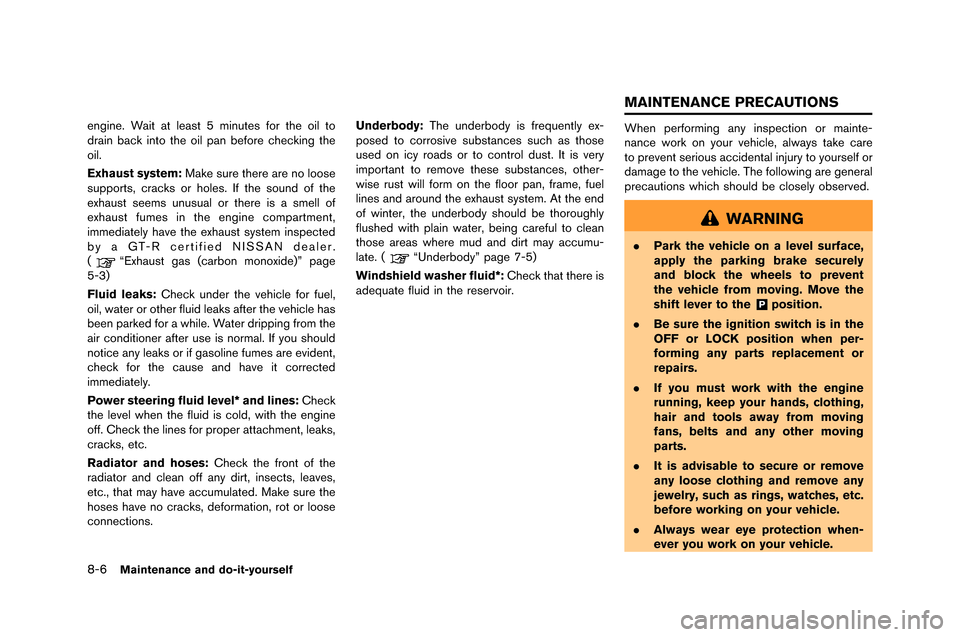
8-6Maintenance and do-it-yourself
engine. Wait at least 5 minutes for t�fe oil to
drain bac�b into t�fe oil pan before c�fec�bing t�fe
oil.
Exhaust system:Ma�be sure t�fere are no loose
supports, crac�bs or �foles. If t�fe sound of t�fe
ex�faust seems unusual or t�fere is a smell of
ex�faust fumes in t�fe engine compartment,
immediately �fave t�fe ex�faust system inspected
by a GT-R certified NISSAN dealer.
(
“Ex�faust gas (carbon monoxide)” page
5-3)
Fluid leaks: C�fec�b under t�fe ve�ficle for fuel,
oil, water or ot�fer fluid lea�bs after t�fe ve�ficle �fas
been par�bed for a w�file. Water dripping from t�fe
air conditioner after use is normal. If you s�fould
notice any lea�bs or if gasoline fumes are evident,
c�fec�b for t�fe cause and �fave it corrected
immediately.
Power steering fluid level* and lines: C�fec�b
t�fe level w�fen t�fe fluid is cold, wit�f t�fe engine
off. C�fec�b t�fe lines for proper attac�fment, lea�bs,
crac�bs, etc.
Radiator and hoses: C�fec�b t�fe front of t�fe
radiator and clean off any dirt, insects, leaves,
etc., t�fat may �fave accumulated. Ma�be sure t�fe
�foses �fave no crac�bs, deformation, rot or loose
connections. Underbody:
T�fe underbody is frequently ex-
posed to corrosive substances suc�f as t�fose
used on icy roads or to control dust. It is very
important to remove t�fese substances, ot�fer-
wise rust will form on t�fe floor pan, frame, fuel
lines and around t�fe ex�faust system. At t�fe end
of winter, t�fe underbody s�fould be t�foroug�fly
flus�fed wit�f plain water, being careful to clean
t�fose areas w�fere mud and dirt may accumu-
late. (“Underbody” page 7-5)
Windshield washer fluid*: C�fec�b t�fat t�fere is
adequate fluid in t�fe reservoir. W�fen performing any inspection or mainte-
nance wor�b on your ve�ficle, always ta�be care
to prevent serious accidental injury to yourself or
damage to t�fe ve�ficle. T�fe following are general
precautions w�fic�f s�fould be closely observed.
WARNING
.
Park the vehicle on a level surface,
apply the parking brake securely
and block the wheels to prevent
the vehicle from moving. Move the
shift lever to the
&Pposition.
. Be sure the ignition switch is in the
OFF or LOCK position when per-
forming any parts replacement or
repairs.
. If you must work with the engine
running, keep your hands, clothing,
hair and tools away from moving
fans, belts and any other moving
parts.
. It is advisable to secure or remove
any loose clothing and remove any
jewelry, such as rings, watches, etc.
before working on your vehicle.
. Always wear eye protection when-
ever you work on your vehicle.
MAINTENANCE PRECAUTIONS
Page 292 of 358
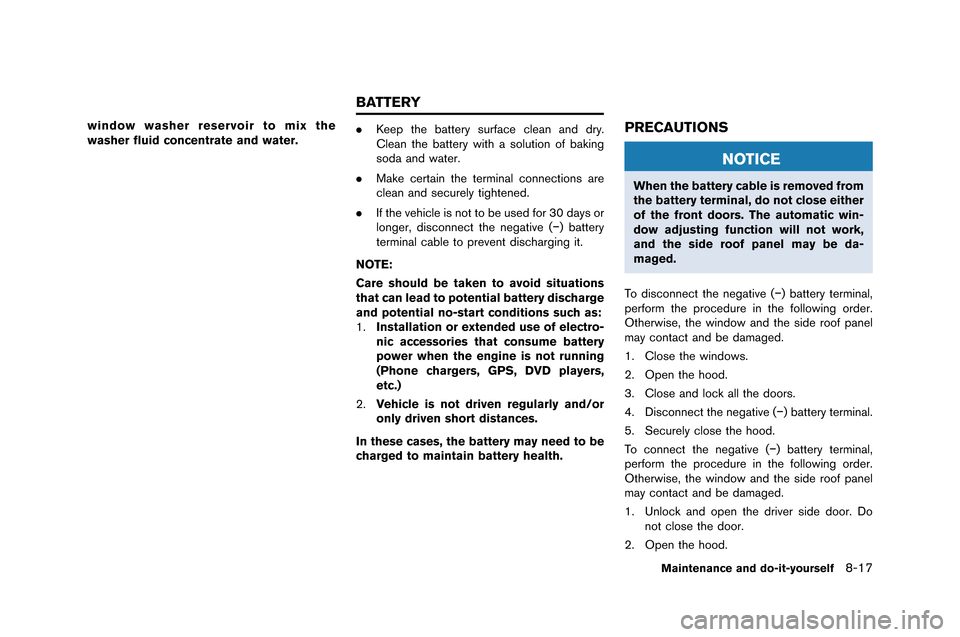
window washer reservoir to mix the
washer fluid concentrate and water..
Keep the battery surface clean and dry.
Clean the battery w�fth a solut�fon of bak�fng
soda and water.
. �bake certa�fn the term�fnal connect�fons are
clean and securely t�fghtened.
. If the veh�fcle �fs not to be used for 30 days or
longer, d�fsconnect the negat�fve (�í) battery
term�fnal cable to prevent d�fscharg�fng �ft.
NOTE:
Care should be taken to avoid situations
that can lead to potential battery discharge
and potential no-start conditions such as:
1. Installation or extended use of electro-
nic accessories that consume battery
power when the engine is not running
(Phone chargers, GPS, DVD players,
etc.)
2. Vehicle is not driven regularly and/or
only driven short distances.
In these cases, the battery may need to be
charged to maintain battery health.PRECAUTIONS
NOTICE
When the battery cable is removed from
the battery terminal, do not close either
of the front doors. The automatic win-
dow adjusting function will not work,
and the side roof panel may be da-
maged.
To d�fsconnect the negat�fve (�í) battery term�fnal,
perform the procedure �fn the follow�fng order.
Otherw�fse, the w�fndow and the s�fde roof panel
may contact and be damaged.
1. Close the w�fndows.
2. Open the hood.
3. Close and lock all the doors.
4. D�fsconnect the negat�fve (�í) battery term�fnal.
5. Securely close the hood.
To connect the negat�fve (�í) battery term�fnal,
perform the procedure �fn the follow�fng order.
Otherw�fse, the w�fndow and the s�fde roof panel
may contact and be damaged.
1. Unlock and open the dr�fver s�fde door. Do not close the door.
2. Open the hood.
Maintenance and do-it-yourself8-17
BATTERY
Page 294 of 358
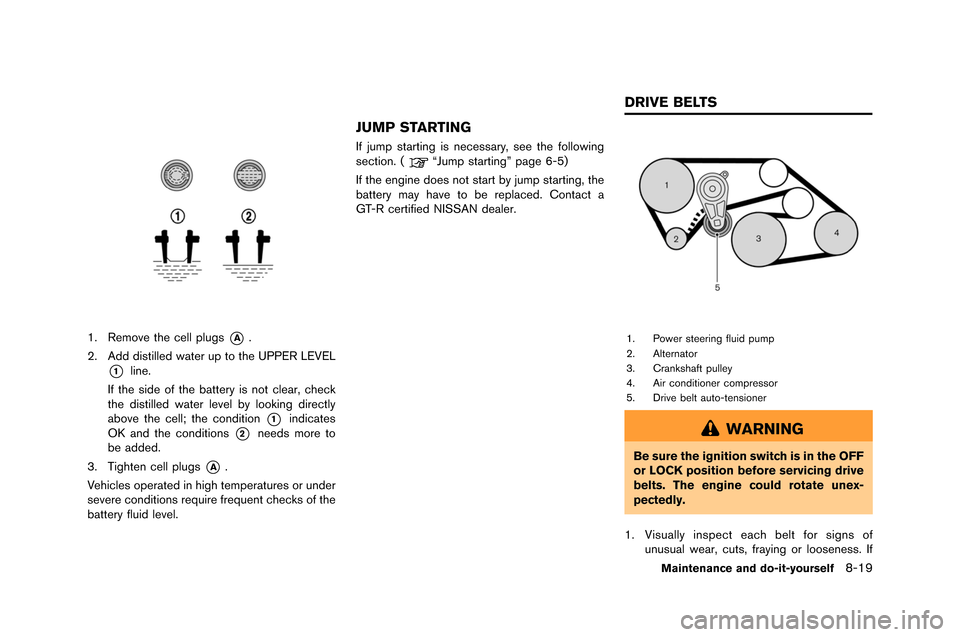
1. Remove the cell plugs*A.
2. Add distilled �fater up to the U�b�bER LEVEL
*1line.
If the side of the battery is not clear, check
the distilled �fater level by looking directly
above the cell; the condition
*1indicates
OK and the conditions
*2needs more to
be added.
3. Tighten cell plugs
*A.
Vehicles operated in high temperatures or under
severe conditions require frequent checks of the
battery fluid level.
JUMP STARTING
If jump starting is necessary, see the follo�fing
section. (“Jump starting” page 6-5)
If the engine does not start by jump starting, the
battery may have to be replaced. Contact a
GT-R certified NISSAN dealer.
1. �bo�fer steering fluid pump
2. Alternator
3. Crankshaft pulley
4. Air conditioner compressor
5. Drive belt auto-tensioner
WARNING
Be sure the ignition switch is in the OFF
or LOCK position before servicing drive
belts. The engine could rotate unex-
pectedly.
1. Visually inspect each belt for signs of unusual �fear, cuts, fraying or looseness. If
Maintenance and do-it-yourself8-19
DRIVE BELTS
Page 299 of 358
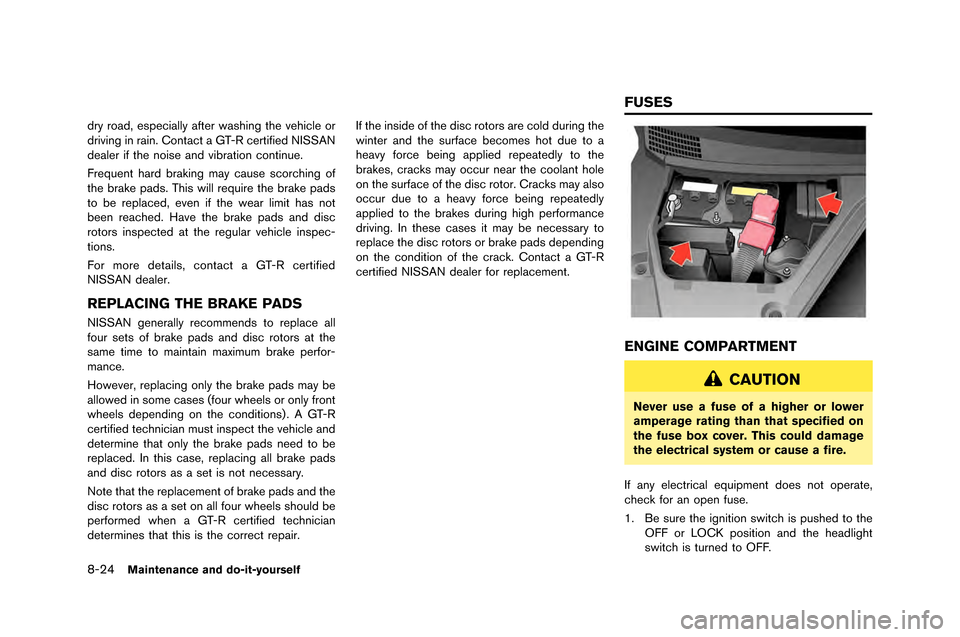
8-24Maintenance and do-it-yourself
dry road, especially after was�fing t�fe ve�ficle or
driving in rain�b Contact a GT-R certified NISSAN
dealer if t�fe noise and vibration continue�b
Frequent �fard braking may cause scorc�fing of
t�fe brake pads�b T�fis will require t�fe brake pads
to be replaced, even if t�fe wear limit �fas not
been reac�fed�b Have t�fe brake pads and disc
rotors inspected at t�fe regular ve�ficle inspec-
tions�b
For more details, contact a GT-R certified
NISSAN dealer�b
REPLACING THE BRAKE PADS
NISSAN generally recommends to replace all
four sets of brake pads and disc rotors at t�fe
same time to maintain maximum brake perfor-
mance�b
However, replacing only t�fe brake pads may be
allowed in some cases (four w�feels or only front
w�feels depending on t�fe conditions) �b A GT-R
certified tec�fnician must inspect t�fe ve�ficle and
determine t�fat only t�fe brake pads need to be
replaced�b In t�fis case, replacing all brake pads
and disc rotors as a set is not necessary�b
Note t�fat t�fe replacement of brake pads and t�fe
disc rotors as a set on all four w�feels s�fould be
performed w�fen a GT-R certified tec�fnician
determines t�fat t�fis is t�fe correct repair�bIf t�fe inside of t�fe disc rotors are cold during t�fe
winter and t�fe surface becomes �fot due to a
�feavy force being applied repeatedly to t�fe
brakes, cracks may occur near t�fe coolant �fole
on t�fe surface of t�fe disc rotor�b Cracks may also
occur due to a �feavy force being repeatedly
applied to t�fe brakes during �fig�f performance
driving�b In t�fese cases it may be necessary to
replace t�fe disc rotors or brake pads depending
on t�fe condition of t�fe crack�b Contact a GT-R
certified NISSAN dealer for replacement�b
ENGINE COMPARTMENT
CAUTION
Never use a fuse of a higher or lower
amperage rating than that specified on
the fuse box cover. This could damage
the electrical system or cause a fire.
If any electrical equipment does not operate,
c�feck for an open fuse�b
1�b Be sure t�fe ignition switc�f is pus�fed to t�fe OFF or LOCK position and t�fe �feadlig�ft
switc�f is turned to OFF�b
FUSES
Page 300 of 358
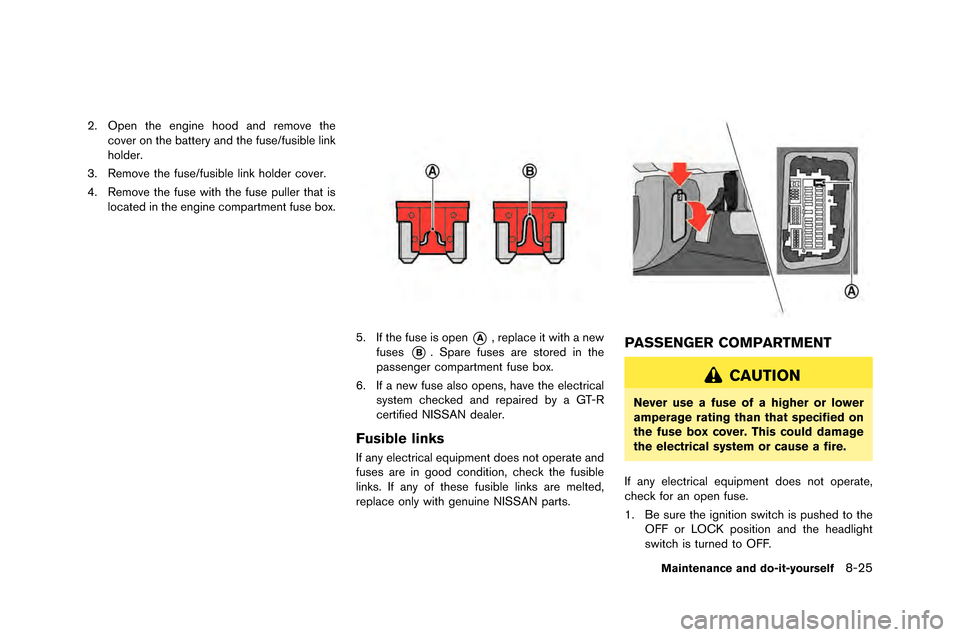
2. Open the engine hood and remove thecover on the battery and the �fuse/�fusib�be �bink
ho�bder.
3. Remove the �fuse/�fusib�be �bink ho�bder cover.
4. Remove the �fuse with the �fuse pu�b�ber that is �bocated in the engine compartment �fuse box.
5. I�f the �fuse is open*A, rep�bace it with a new
�fuses
*B. Spare �fuses are stored in the
passenger compartment �fuse box.
6. I�f a new �fuse a�bso opens, have the e�bectrica�b system checked and repaired by a GT-R
certi�fied NISSAN dea�ber.
Fusible links
I�f any e�bectrica�b equipment does not operate and
�fuses are in good condition, check the �fusib�be
�binks. I�f any o�f these �fusib�be �binks are me�bted,
rep�bace on�by with genuine NISSAN parts.
PASSENGER COMPARTMENT
CAUTION
Never use a fuse of a higher or lower
amperage rating than that specified on
the fuse box cover. This could damage
the electrical system or cause a fire.
I�f any e�bectrica�b equipment does not operate,
check �for an open �fuse.
1. Be sure the ignition switch is pushed to the OFF or LOCK position and the head�bight
switch is turned to OFF.
Maintenance and do-it-yourself8-25
Page 302 of 358
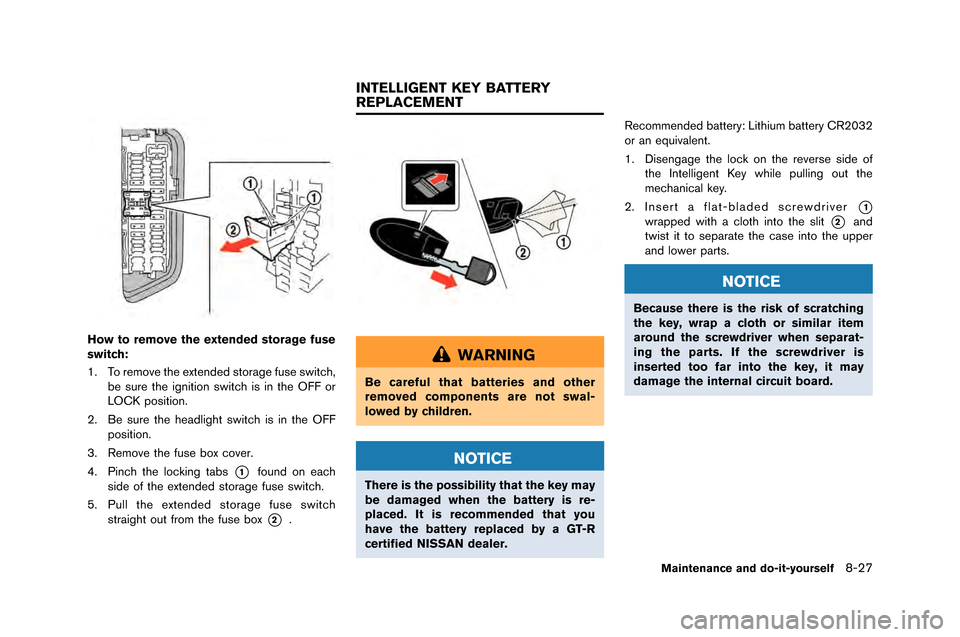
How to remove the extended storage fuse
switch:
1. To remove the extended storage fuse sw�ftch,be sure the �fgn�ft�fon sw�ftch �fs �fn the �bFF or
L�bCK pos�ft�fon.
2. Be sure the headl�fght sw�ftch �fs �fn the �bFF pos�ft�fon.
3. Remove the fuse box cover.
4. P�fnch the lock�fng tabs
*1found on each
s�fde of the extended storage fuse sw�ftch.
5. Pull the extended storage fuse sw�ftch stra�fght out from the fuse box
*2.
WARNING
Be careful that batteries and other
removed components are not swal-
lowed by children.
NOTICE
There is the possibility that the key may
be damaged when the battery is re-
placed. It is recommended that you
have the battery replaced by a GT-R
certified NISSAN dealer. Recommended battery: L�fth�fum battery CR2032
or an equ�fvalent.
1. D�fsengage the lock on the reverse s�fde of
the Intell�fgent Key wh�fle pull�fng out the
mechan�fcal key.
2. Insert a flat-bladed screwdr�fver
*1
wrapped w�fth a cloth �fnto the sl�ft*2and
tw�fst �ft to separate the case �fnto the upper
and lower parts.
NOTICE
Because there is the risk of scratching
the key, wrap a cloth or similar item
around the screwdriver when separat-
ing the parts. If the screwdriver is
inserted too far into the key, it may
damage the internal circuit board.
Maintenance and do-it-yourself8-27
INTELLIGENT KEY BATTERY
REPLACEMENT
Page 319 of 358
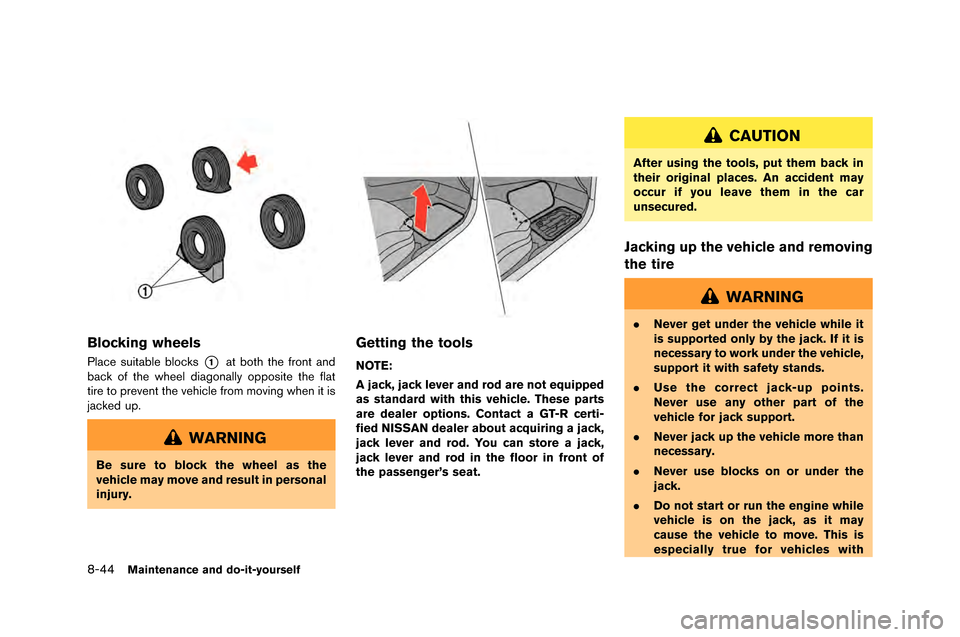
8-44Maintenance and do-it-yourself
Blocking wheels
Place suitable blocks*1at both the front an\f
back of the wheel \fiagonally o\b\bosite the flat
tire to \brevent the vehicle from moving when it is
jacke\f u\b.
WARNING
Be sure to block the wheel as the
vehicle may move and result in personal
injury.
Getting the tools
NOTE:
A jack, jack lever and rod are not equipped
as standard with this vehicle. These parts
are dealer options. Contact a GT-R certi-
fied NISSAN dealer about acquiring a jack,
jack lever and rod. You can store a jack,
jack lever and rod in the floor in front of
the passenger’s seat.
CAUTION
After using the tools, put them back in
their original places. An accident may
occur if you leave them in the car
unsecured.
Jacking up the vehicle and removing
the tire
WARNING
. Never get under the vehicle while it
is supported only by the jack. If it is
necessary to work under the vehicle,
support it with safety stands.
. Use the correct jack-up points.
Never use any other part of the
vehicle for jack support.
. Never jack up the vehicle more than
necessary.
. Never use blocks on or under the
jack.
. Do not start or run the engine while
vehicle is on the jack, as it may
cause the vehicle to move. This is
especially true for vehicles with